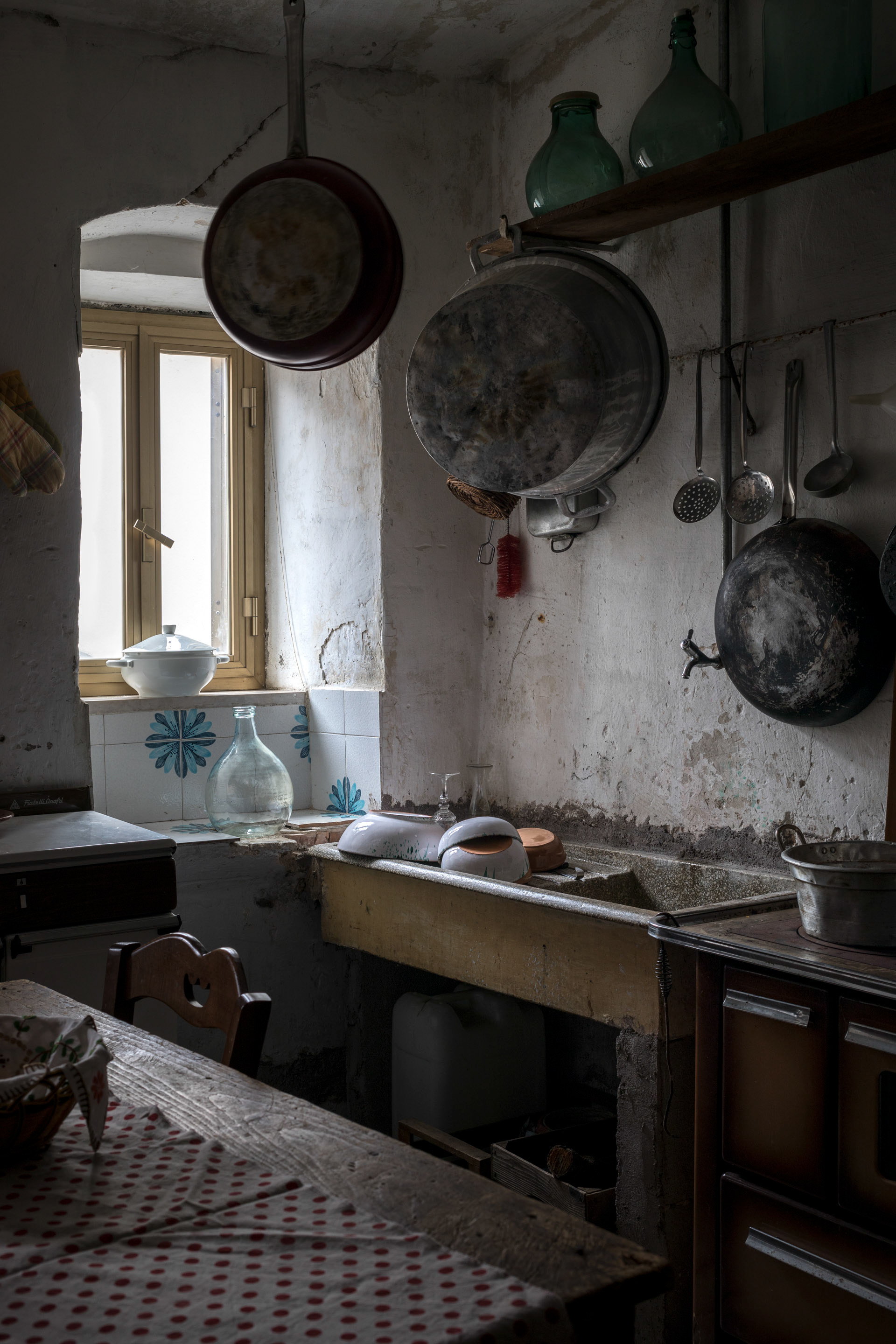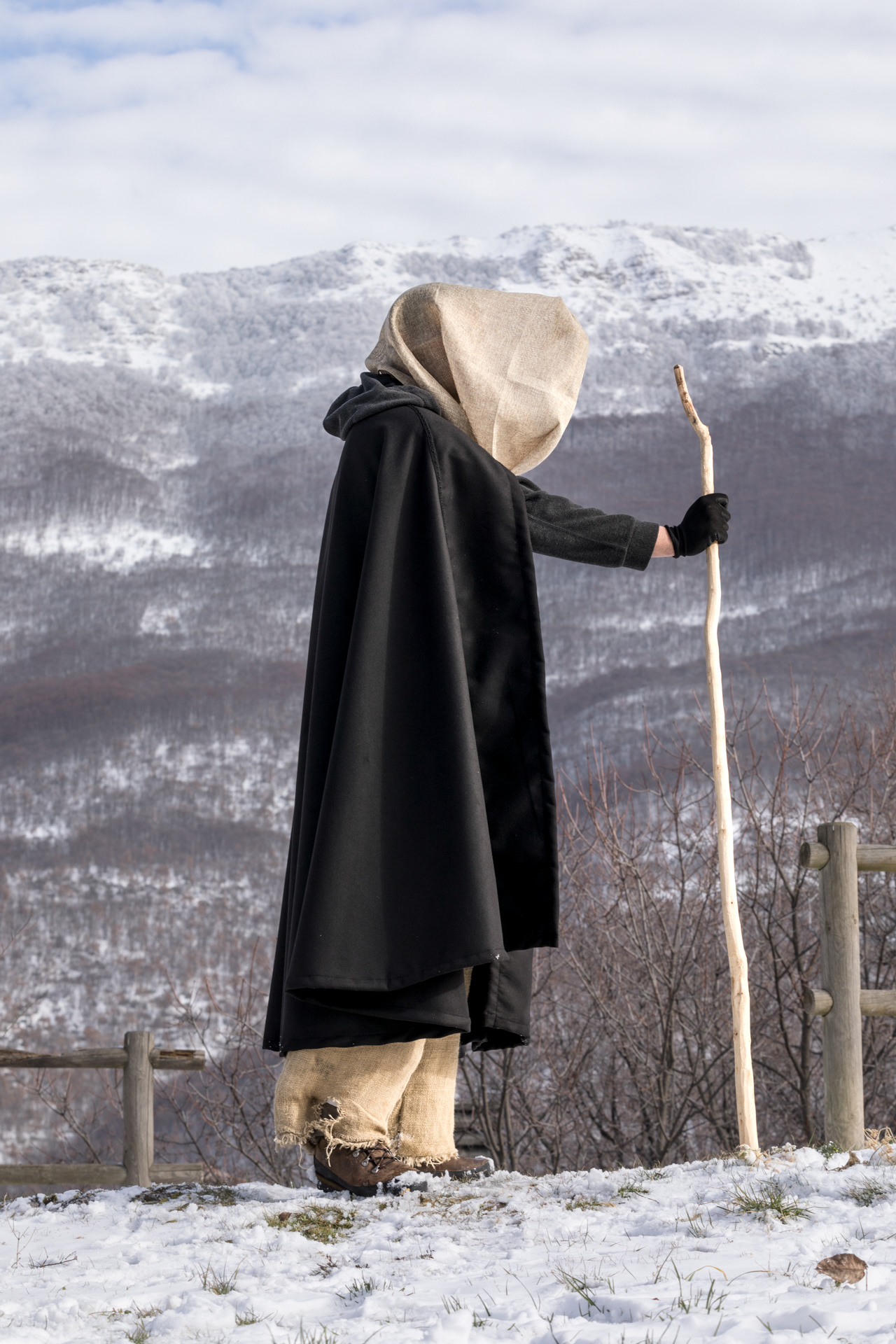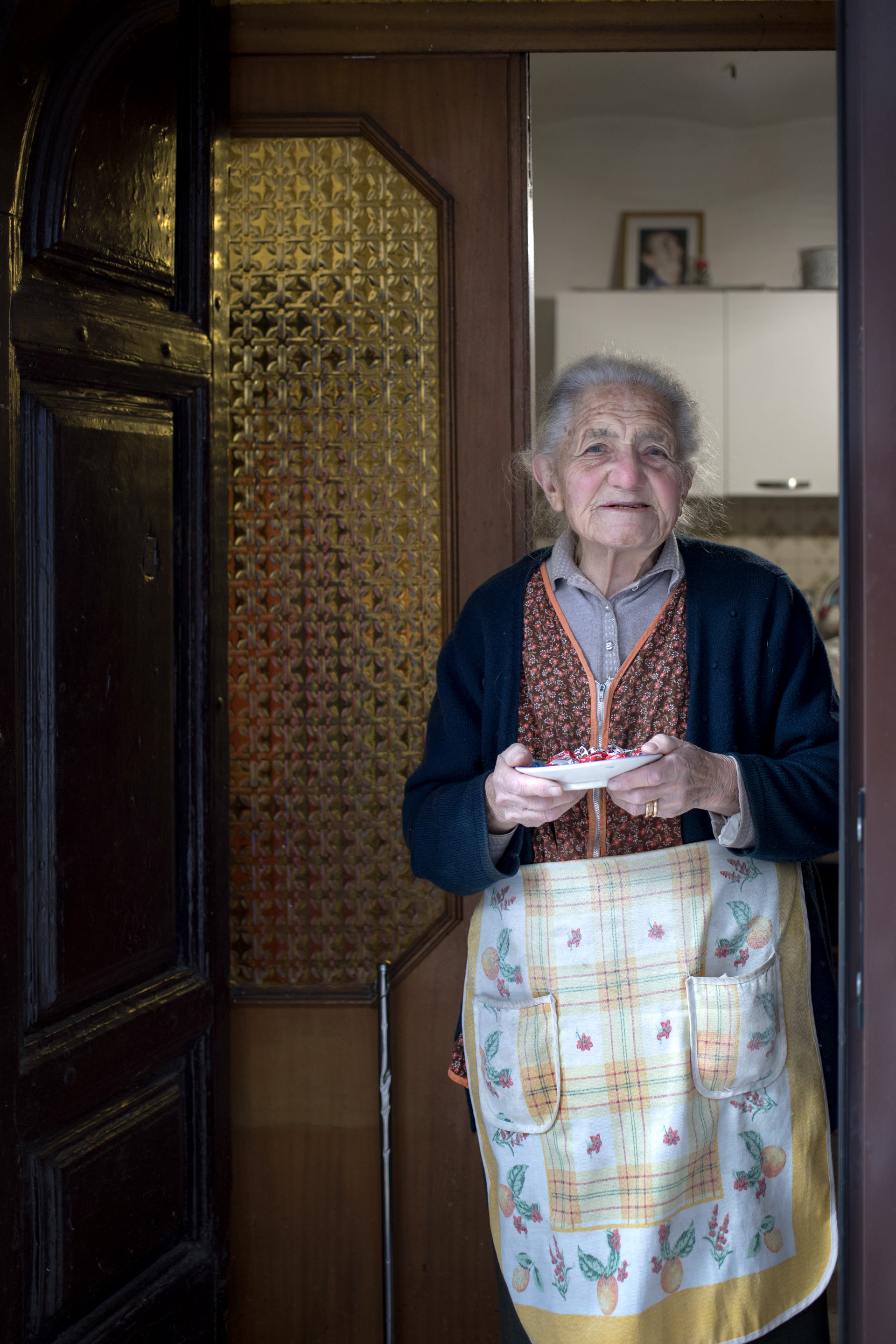“La Panarda,” an abundant feast offered to the community as alms and as a restorative, has deep roots in Abruzzo and Central Italy.
An American of Abruzzese descent, his wife, and the chef at their Philadelphia restaurant journeyed to Villavallelonga to experience this ritual and better understand the role played by food and communal dining in creating community.
An American of Abruzzese descent, his wife, and the chef at their Philadelphia restaurant journeyed to Villavallelonga to experience this ritual and better understand the role played by food and communal dining in creating community.
In Abruzzo’s largely remote interior, honoring the host and bolstering community at the table have sacred significance and a long history. La Panarda traces its origins back to tumultuous and precarious times, between the 1500s and 1700s. Today, the tradition continues in the village of Villavallelonga, where it takes place on Saint Anthony Abbott’s day, January 16th, and ends early the next morning.
In Villavallelonga, the tradition has been enriched with religious meaning and customs related to the natural world and the changing of the seasons. In this still-often wild part of the Apennines, the Panarda is accompanied by rituals marking the transition from the extreme dark of winter to the first signs of spring light. During the days preceding the Panarda, figures in symbolic masks roam the village: Saint Anthony himself, devils, “ugly men,” and fantastic forest creatures. They represent the eternal struggle between good and evil, light and dark, wild and domestic worlds. Abruzzo is cold in the winter, a hard and often unforgiving territory, still fiercely tied to ancient agrarian and pastoral traditions. The Panarda arises from that context as a unique celebration of community, seasonal rhythms, and rebirth.
This past January, Francis Cretarola, Catherine Lee, and Chef Andrew Wood had come to the village on a mission. The trip was part of a years-long journey rediscovering the so-called “cucina povera,” or cuisine of the poor. Their hope was to bring back some of what they learned in Abruzzo to Philadelphia, to strengthen the ties of solidarity, mutual responsibility, and respect. By reimagining the Panarda in Philadelphia, they hoped to foster a different mode of fellowship through the beauty of cuisine and the pleasure of convivial exchange.

A handful of fava beans in the hands of a member of the Bianchi family.
Although the festival has specific religious connotations, it’s essentially secular. In general, and historically, the Panarda as a feast of abundance fits within the framework of rituals in traditional cultures acknowledging the beginning of the new year and auguring the best in all the essential aspects of daily life: food, health, prosperity, and general for- tune. This extends to agricultural production and the raising of animals: crops, harvests, working beasts, and livestock.
The singularity of Villavallelonga’s Panarda, with its unique components and ritual steps, has drawn the attention of scholars, anthropologists, and regional cultural institutions who’ve proposed its candidacy for acknowledgment by UNESCO as an example of humanity’s intangible heritage.
The most spectacular aspect of Villavallelonga’s Panarda lies in the quantity of the courses, which can reach and even exceed fifty, and in the etiquette that requires diners to honor the table by consuming all the dishes set before them. This rite of consumption celebrates a reconciliation with St. Anthony Abbot.

Ugly masks (mascar brutt) are impersonated by men bundled up in old clothes, filled with straw, their faces painted black, with horns and animal skins and an onion in their mouth or hidden by a sack who run through the streets of the country dragging chains, making noise and scaring children.

The Devil’s Mask. The origin of the Panarda of Villavallelonga, ac- cording to oral tradition, goes back to the fulfillment of a vow for grace received by the Serafini family, which was protected by St. Anthony from a deception by the devil.

A portrait of Frencis Cretarola, an American of Abruzzese descent.

The typical bread, knowed as “Panetta” that is offered along with fava bean soup on the morning of January 17.

A glimpse of a traditional kitchen, used these days as the site of an Abruzzi cooking workshop.

A portrait of Andrew, the chef at Le Virtù restaurant in Philadelphia.

A winter view of Abruzzi National Park.

Portrait of a young men from Villavallelonga in traditional dress

Portrait of a young woman in traditional dress
According to oral tradition, the origin of Villavallelonga’s Panarda can be traced to a vow made by a member of the Serafini clan.
Legend tells of landowner Mariano Serafini, who could find no workers to harvest his wheat. Despondent, he cursed, saying he would make the devil reap the grain. At that utterance, men appea- red from nowhere and offered their help in the har- vest, asking only that no salt be added to the food they would eat mid-day. Mariano accepted their of- fer but forgot their request. When his wife arrived with the workers’ lunch, the reapers asked if it was salt-free. Surprised by the oddity of the question, the woman made the sign of the cross. She’d not yet finished her invocation when the men vanished, disappearing amid tongues of fire. Only then did Mariano and his wife realize that the footprints left behind by the reapers weren’t human but instead resembled those of goats. They realized that they’d been dealing with the devil. The woman implored St. Anthony to free and protect them from the de- vil and his temptations, promising to distribute as alms, in his honor, for years to come, until the end of their line, food like that which the reapers were to consume.
Legend tells of landowner Mariano Serafini, who could find no workers to harvest his wheat. Despondent, he cursed, saying he would make the devil reap the grain. At that utterance, men appea- red from nowhere and offered their help in the har- vest, asking only that no salt be added to the food they would eat mid-day. Mariano accepted their of- fer but forgot their request. When his wife arrived with the workers’ lunch, the reapers asked if it was salt-free. Surprised by the oddity of the question, the woman made the sign of the cross. She’d not yet finished her invocation when the men vanished, disappearing amid tongues of fire. Only then did Mariano and his wife realize that the footprints left behind by the reapers weren’t human but instead resembled those of goats. They realized that they’d been dealing with the devil. The woman implored St. Anthony to free and protect them from the de- vil and his temptations, promising to distribute as alms, in his honor, for years to come, until the end of their line, food like that which the reapers were to consume.

The Mask of the Wolf. legend has it that St. Anthony saved a child from the jaws of a wolf.

An Ugly masks (mascar brutt). This type of mask has always represented the wild world of the forest or mountain areas.

Ugly masks (mascar brutt)

A glimpse of the village of Villavallelonga.
To truly partake in the spirit of the Panarda in Villavallelonga, is to reject the individualistic attitudes that characterize our age.
The ritual brings atheists and the religious, and lo- cals and foreigners, to a common place, a shared existence in and appreciation of the moment. Time slows as the night passes with the succession of dishes. In this languid interlude, the community opens itself to the less fortunate, the poor, and offers hospitality and nourishment to those with nowhere to go. An empty plate is always set at the table in anticipation of the arrival of someone in need.
The ritual brings atheists and the religious, and lo- cals and foreigners, to a common place, a shared existence in and appreciation of the moment. Time slows as the night passes with the succession of dishes. In this languid interlude, the community opens itself to the less fortunate, the poor, and offers hospitality and nourishment to those with nowhere to go. An empty plate is always set at the table in anticipation of the arrival of someone in need.
For Villavallelonga’s Panarda has one great rule: that no one is left alone or hungry that night.

The explosion of fireworks, marks the end of the religious celebrations.

The portrait of Catherine Yai Wen Lee, Francis’s companion. Together they run an Abruzzese cuisine restaurant in Philadelphia

The procession of the statue of St. Anthony, a wooden statue from the 1600s.

"I frascaréglie" (frascarelli): a dough consisting of flour, eggs and water mixed and kneaded to form granules hardened by drying.
Another distinguishing aspect of Villavallelonga’s recurring tradition is “La Favata.” At dawn on the 17th of January (and also on the days preceding the Panarda), designated families distribute boiled, seasoned broad beans along with bread kneaded with eggs (“la Panetta”). They divide the town into precise sections, with each family responsible for delivering the food from house to house in that specific area.
The Favata is believed to be the Bianchi family’s (“i Pgnatune”) offer of repayment for a grace received from St. Anthony. Popular legend holds that a baby was kidnapped from its crib by a wolf, and the de- sperate mother invoked the saint’s help, promising to hold what is known as a fire festival (of which the Favata is part) in his honor for the remainder of her life.

Favata cooking is done in a large cauldron.

Pasquarella, 96, the oldest lady in Villavallelonga, who still continues to cook Panarda and follow this ancient tradition.

A group of young people from Pro Sant’Antionio in traditional clothes and instruments. During the week of the Panarda, among the streets of the village, the song dedicated to the saint played by these boys can be heard over and over again.

A glimpse of Villavlallelonga.

An inhabitant of Villavallelonga receive the fave soup before going to work.

A plate of “Favata” with “Panetta,” the typical Panarda bread. Distribution of the “Favata” at dawn on January 17. Descendants of the Bianchi family continue to this day to hand down the distribution of the “Favata” to the entire community, going house to house.

A view of "Piana del Fucino", a former lake on the Abruzzo's plateau at 1000 m on sea level.
The 17th-century wooden statue of St. Anthony Abbot is adorned with so-called Crowns, consisting of fava beans, apples, oranges, tangerines, and dried figs held together by string. The Wreaths are mostly made by elders as a good-luck gift for young children in the family.
After the procession in which the statue of the saint is carried through the streets of the town, the who- le community gathers in the main square. Here the blessing of the animals takes place, to maintain the community’s link with its past and its rural and pastoral origins.
The feast of St. Anthony manifests in a complex sy- stem of rituals rich in symbolism (masks, baskets, wreaths, fires) that can be examined from multiple perspectives. Its main moment, however, is found in the Panarda, a banquet in which everyone participates in an atmosphere of exceptional solidarity and sense of community, holding themselves obligated to maintain a tradition that belongs to the common cultural heritage.

The ancient wooden statue of St. Anthony.

A mule with the image of the saint on its bridle.
